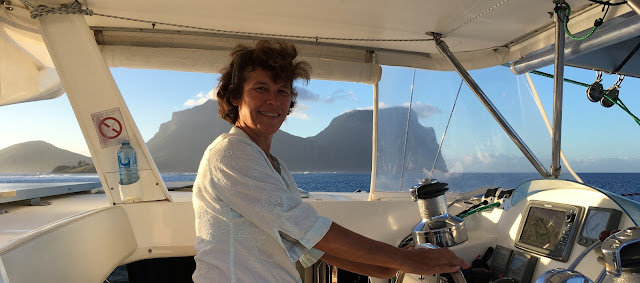It's hard to take a photo of Lord Howe Island that doesn't have a mountain in it. Suitably imposing is Mt Lidgbird (named after the Captain who discovered this extinct volcano), but the one everyone talks about is Mt Gower (otherwise known as Big Hill; to the right of this photo).
The usual question is; Did you climb it?
But the question that puzzled me was; Who was Gower?; and that proved surprisingly hard to answer.
In the meantime; Did we climb it?
But because it was covered in cloud, blowing a gale, and intermittently pouring with rain, we coasted on the fact that George had climbed it many years before, and decided to admire it from sea level.
Now, back to the mystery of its namesake. Eventually, I tracked it down in an obscure place names register (can't actually find the website again!). However, I can relieve your growing curiosity by telling you that it was named after John Leveson-Gower, also known as The Baron Gower; who was a Tory politician and also served as Privy Seal. I didn't know what a "Privy Seal" was although it sounded suspiciously like a means for making one's toilet watertight. It turns out to be an archaeic office (but one that is still filled). According to Wikipedia: Though one of the oldest offices in government anywhere, it has no
particular function today because the use of a privy seal has been
obsolete for centuries. A notable 20th century appointee, Ernest Bevin, commented on leaving office that he was "neither a Lord, nor a Privy, nor a Seal".
I have digressed seriously. One of the reasons I like writing these blogs, though, is for what I discover in the process, and this was one of those occasions. It also detracts attention from the fact that we did NOT climb the famous Mt Gower (or Big Hill), which is a shame because it hosts a spectacular mist forest, with a large range of endemic species not (by definition) to be found anywhere else.
About 50% of the terrestrial species on Lord Howe Island are unique, including animals such as the Lord Howe Island stick insect (eradicated from the main island by rats but about to reintroduced from a small population discovered on Ball's Pyramid), the LHI skink and gecko and (although we fortunately did not encounter it) the large forest bat.
Cycling around the island was good exercise and allowed us to explore many other areas.
We rode past the airstrip in time to see QF 2265 take off. Two hours later it would land in Sydney; roughly 28 times faster than we would get there. And although the flight is often turbulent, it would not match our voyage home, as you will see in Part 3.
 | ||
| Time for a breather. |
We visited Pinetrees Lodge; having heard nice tales from family members who holidayed there; and afternoon tea turned into Happy Hour.
To be continued.










No comments:
Post a Comment